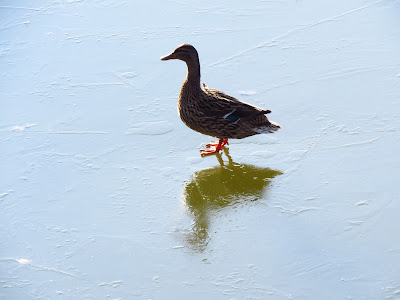I started my walk by a WeBS count at Pearson Park. Helen B. told me she had seen a ringed Common Gull and showed me her photo, orange with 2CAT in black. I told her about the reporting colour rings help page and headed on. The Moorhen was at her nest in the wicker basket, and the new Coot pair appeared to have started their nest. I surveyed the Common Gulls, who were resting on the grass after feeding and spotted JP870 white ring that we saw a couple of weeks ago and 2CAT with orange ring. At home I checked and it was ringed by a scheme near York run by Mike Jackson, most likely during the winter. I think this is the first UK ringed Common Gull I've seen in the park,. There were 152 common gulls in today's count, but others were at the playing field at Sculcoates with a mainly Black-headed Gull roost.

JP870 Common Gull.
Orange 2CAT looks like a young gull, muted grey-blue bill and legs.
Starling singing in usual spot at drain.
The drain was iced up, only a few patches under bridges and at outflows remained free of ice, but it was melting fast.
It was 50 min after high tide, so I headed for the river. 9 Redshank were at the roost. Numbers this year have been of 9 maximum, last year they used to be 12.
This Lesser Black-backed gull was exploring a low flat roof on the spot where I used to be mobbed by them last year.
I took a short walk around the cemetery. Rattling calls of crows and alarm sirens of gulls brought me running from under the trees for a clear view of the sky. A male Sparrowhawk was soaring high. As I walked back I noticed the female.
Sunshine and thermals despite the icy start got the Sparrowhawk pair rising and displaying high over their territory near the drain. The Herring gulls are only thinking about breeding, they have nothing to fear from Sparrowhawks, but they flew in panic, calling plaintively and mobbing the raptor.
The Jackdaw pair who feeds around the gull roost was there. I am very intrigued as to what they are feeding on, but they tend to feed near the gulls. When the roost was spooked, the two Jackdaws struggled to fly up as fast as the gulls.
Back at home, more gull alarms pointed at two Buzzards soaring. A Blackbird couldn't see them as it was in the opposite side of the holly, feeding on ivy berries. It did look up, looking alarmed. This week I've been noticing eavesdropping in birds. Feral Pigeons flew up at the alarm call of a Blue Tit, another occasion to gull alarm calls.













3 comments:
We had two Norwegian ringed Common Gulls in Kensington Gardens recently, but they only had metal rings, not plastic ones with a J number. They were spotted by the indefatigable Alan Gibson, who specialises in gull rings and goes around with a scope on a tripod.
It is very satisfying to find a ringed gull and being able to read the ring, but really hard if it only has a metal one. I once read the metal ring of a Black-headed Gull in one of our parks, as I was very close, but there is a single wintering Mediterranean Gull that is ringed with a metal ring and is much shyer, maybe some time!
It's almost impossible with binoculars and the small ring on a Black-Headed Gull. I try to walk around the gull with a telephoto lens taking pictures from all angles and read the ring at home.
Post a Comment